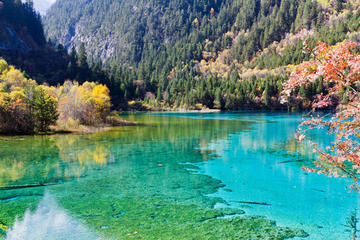Jiuzhaigou Valley
TIME : 2016/2/22 10:14:10

Jiuzhaigou Valley
Set in northern Sichuan Province, Jiuzhaigou Valley is regarded by many Chinese as a place akin to being heaven on Earth. One of China’s most famous National Parks, Jiuzhaigou Valley is also recognized as a UNESCO World Heritage Site where giant pandas (albeit only about 20) still roam the forested hillsides. A remote wilderness set on the steps of the Tibetan Himalayan Plateau, Jiuzhaigou Valley is a 278 square mile (720 square kilometer) wonderland of turquoise lakes, cascading waterfalls and snowcapped mountain peaks which form the southern edge of the Minshan mountain range.
Jiuzhaigou Valley is literally translated as “Nine Village Valley,” of the nine Tibetan villages from which the park derives its name, and seven are still inhabited and accessible to park visitors and trekkers. With a population numbering little more than 1,000 inhabitants, the simple villages of Jiuzhaigou are an alluring and mystical complement to the pristine panoramas and scenery.
Located 205 miles (330 kilometers) from the city of Chengdu, this once inaccessible valley is rapidly growing in visitor popularity and is now accessible by either a ten hour bus ride or a 40 minute plane flight. Myriad trekking options lay scattered throughout the park, despite elevations which range from 6,600 to 15,700 feet (10,621.7 to 25,266.7 kilometers). Scores of visitors opt to trek to serene backcountry outposts such as Five Color Pond in the Zechara Gully, where travertine mineral formations provide a kaleidoscope of colors drifting in the high-altitude waters.
While the presence of wild giant pandas understandably dominates talk of the park’s flora and fauna, Jiuzhaigou Valley also houses over 140 bird species as well as golden monkeys, golden pheasants and the rarely sighted and reclusive snow leopards. Though the future of Jiuzhaigou Valley remains uncertain amid concerns over growing visitor numbers, the entire region nevertheless ranks as one of China’s most revered and scenic natural outposts.
